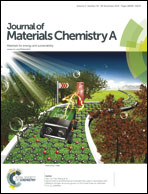The local atomic structure and chemical bonding in sodium tin phases†
Abstract
To understand the electrochemically-derived Na–Sn we have reinvestigated the formation of Na–Sn alloys to identify all the phases which form when x ≥ 1 (NaxSn) and characterized the local bonding around the Sn atoms with X-ray diffraction, 119Sn Mössbauer spectroscopy, and X-ray absorption spectroscopies. The results from the well-defined crystallographic materials were compared to the spectroscopic measurements of the local Sn structures in the electrochemically prepared materials. The reinvestigation of the Na–Sn compounds yields a number of new results: (i) Na7Sn3 is a new thermodynamically-stable phase with a rhombohedral structure and R![[3 with combining macron]](https://www.rsc.org/images/entities/char_0033_0304.gif) m space group; (ii) orthorhombic Na9Sn4 (Cmcm) has relatively slow formation kinetics suggesting why it does not form at room temperature during the electrochemical reaction; (iii) orthorhombic ‘Na14.78Sn4’ (Pnma), better described as Na16−xSn4, is Na-richer than cubic Na15Sn4 (I
m space group; (ii) orthorhombic Na9Sn4 (Cmcm) has relatively slow formation kinetics suggesting why it does not form at room temperature during the electrochemical reaction; (iii) orthorhombic ‘Na14.78Sn4’ (Pnma), better described as Na16−xSn4, is Na-richer than cubic Na15Sn4 (I![[4 with combining macron]](https://www.rsc.org/images/entities/char_0034_0304.gif) 3d). Characterization of electrochemically prepared Na–Sn alloys indicate that, with the exception of Na7Sn3 and Na15Sn4, different crystal structures than similar Na–Sn compositions prepared via classic solid state reactions are formed. These phases are composed of disordered structures characteristic of kinetic-driven solid-state amorphization reactions. In these structures, Sn coordinates in asymmetric environments, which differ significantly from the environments present in Na–Sn model compounds.
3d). Characterization of electrochemically prepared Na–Sn alloys indicate that, with the exception of Na7Sn3 and Na15Sn4, different crystal structures than similar Na–Sn compositions prepared via classic solid state reactions are formed. These phases are composed of disordered structures characteristic of kinetic-driven solid-state amorphization reactions. In these structures, Sn coordinates in asymmetric environments, which differ significantly from the environments present in Na–Sn model compounds.


 Please wait while we load your content...
Please wait while we load your content...